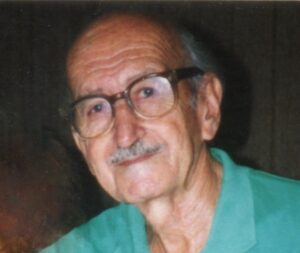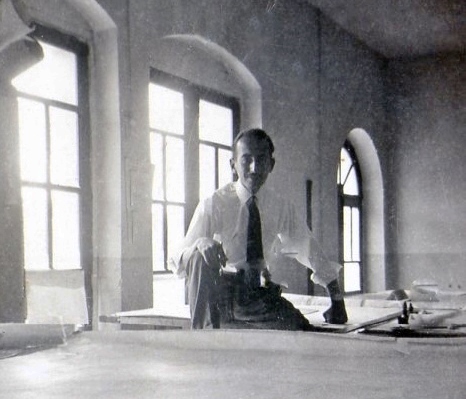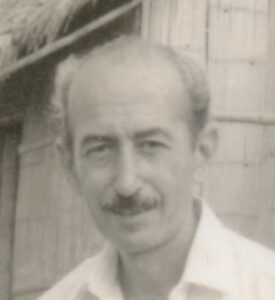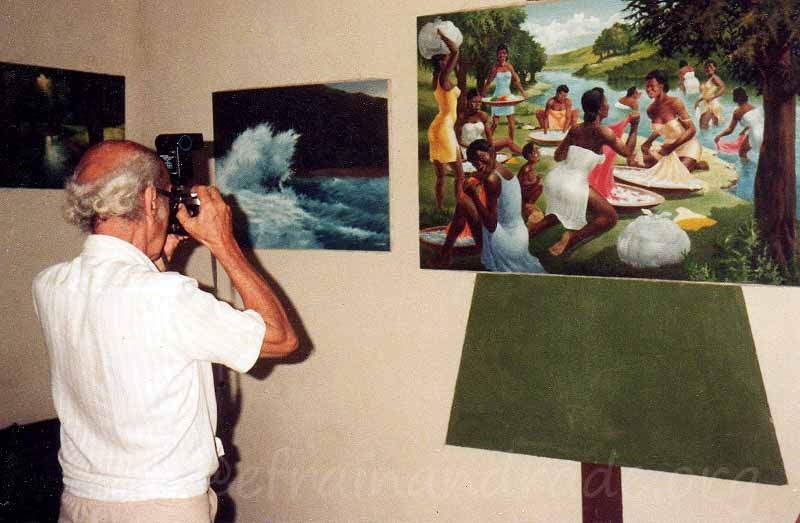Efraín Andrade Viteri
"Pioneer of the pictorial culture of Esmeraldas"

Efraín Andrade brought out the culture of Esmeraldas through his paintings and mural sculpture. Dreamer in spirit but realistic in his art, Andrade marked an era in the history of the artistic life of Esmeraldas. He was the first artist to hold an art exhibition in the Casa de la Cultura in 1951. These drawings and paintings were the first artistic expression of Afro-Esmeraldean Culture.
The awards he received acknowledged his artistic ability and unique contribution to the art and culture of Esmeraldas.
Plan Regulador de la ciudad de Quito

From 1942 to 1945 Andrade utilized his architectural expertise at the project “Plan Regulador” led by Dr. Humberto Albornoz head of the Municipality of Quito. This project developed the first formal city planning of Quito, capital of Ecuador.
by Demetrio Aguilera Malta
“Efraín Andrade is a preeminent figure in the art world of Esmeraldas. Born in Loja and educated in Quito, this artist has grafted together a meticulous and almost-Benedictine pen technique with an inspiring flow of black culture, creaky jungle, revived myths, and landscapes dotted with sorcery and witchcraft”
By: Novelist Demetrio Aguilera Malta
At art exhibit held at Bodegón Hall, Central University of Quito.
Published in Tierra Verde, Casa de la Cultura Ecuatoriana Magazine, June, 1958

“Why did Andrade become fond of Esmeraldas and took root there? Because he was seduced not only by his landscapes, beaches and climate, but because he fell in love with the people, their contagious joy and culture, the music and folk dances. And there he stayed; he planted his easel and canvases and began to portray everything he saw in Esmeraldas”.
Inés María Flores Benavides, Critic and Art Historian. Quito, 2015
Efraín Andrade Viteri was born May 15, 1920 in Loja, Ecuador to Jaime Humberto Andrade Arteaga and Elina Josefa Viteri Aimar. He studied painting and architecture at the “Escuela de Bellas Artes” in Quito.
In 1941 Andrade moved to Manabí with the sole purpose to paint, and by the end of this year he had completed a collection of oil paintings and portraits using his already mastered “pen and ink” technique. He presented his first exhibition in Manabí at the Hall of the “Casa de la Cultura” and soon after that, he returned to Quito to join the team at the “Plan Regulador” assigned to develop the first formal planning of the city of Quito.
Andrade moved to Bogotá, Colombia in 1947 where he worked as a draftsman and where he presented an exhibition at “Bogota Fine Art and Cultural Center”.
His concerns with social issues were expressed in his collection of photographs taken in the Lima and Cuzco areas where he traveled during 1948. In Cuzco he also reaffirmed his curiosity and admiration for the ancient ruins and the history behind them by spending time making the ruins of Machu Picchu his “still-models” and playing with light and contrast to obtain photographs worth to be displayed in a gallery.
Andrade traveled throughout Colombia and Peru developing friendships and a more comprehensive understanding of fine arts and cultural expression. From 1941 through 1990 he exhibited his paintings in Ecuador, Colombia and Venezuela.
In 1950 after marrying Flor de Maria Vásquez Tello, moved to the remote and beautiful province of Esmeraldas. Nature was always the frame of his paintings, and his encounter with the natural environment was manifested from his arrival to this green province which he adopted as his own. Andrade exalted the value of nature as companion to human existence, and his eyes saw beyond the human figure, he saw the joy and pain that gave them life, and he felt privileged to capture on canvas the feelings of the people from Esmeraldas.
He was not satisfied to admire the beauty of the Esmeraldas Province, he wanted to perpetuate the splendid beaches, the green of the hills, the deep blues of the sky, and more important, he wanted others to know about the amazing people and their daily life, their feelings, happiness and sorrows. The sensual woman dancing to marimba music, the expression of joy of a child by the river bank, the sweat on the back of a man carrying a banana bunch, and the suffering of a father watching his son’s body recently deceased during the wake.
Andrade has been recognized as the first Ecuadorian artist who painted and represented the life and culture of the people of Esmeraldas.
Born: May 15, 1920 in Loja, Ecuador
Died: July 1, 1997 in Esmeraldas, Ecuador
Studies:
Pensionado Mercedario, Quito (1926-1930)
Anexa del Normal Juan Montalvo, Quito (1930-1932)
Mejía High School, Quito (1932-1937)
School of Fine Arts, Quito (1937-1941)
Activities:
1942 Member of the “Quito City Plan Project”
1955 Member and Columnist of Hélice Cultural Magazine.
1956 Designed Folke Anderson Stadium’s Mural.
1959 Sub-Director of “Hélice” Cultural Magazine
1960 City Planning Director, Municipality of Esmeraldas
1964 Designed Mural “Embarque de Banano” Central Bank
Main Exhibits:
House of Ecuadorian Culture, Portoviejo, 1941
House of Cultural and Fine Arts, Bogotá, Colombia, 1947
House of Ecuadorian Culture, Portoviejo, 1948
Colonial Art Museum, Quito, 1949
House of Ecuadorian Culture, Esmeraldas, 1951
House of Ecuadorian Culture, Ambato, 1952
Colombo Americano, Caracas, Venezuela, 1952 House of Ecuadorian Culture, Quito, 1956 Bodegón University Hall, Quito, 1958
Colonial Art Museum, Quito, 1969
Colonial Art Museum, Quito, 1982
Mariano Aguilera Gallery, Quito, 1987
Torres y Torres Gallery, Quito, 1991
Central Bank Museum, Esmeraldas, 2001
Casa de la Cultura, Esmeraldas, 2014
Casa de la Cultura, Quito, 2015
Awards: 1968 Diploma of Honor from Manabí Artists Association
1984 Honorable Mention, Municipality of Esmeraldas
1988 “Simón Plata Torres” Gold Medal
1995 Honorable Provincial Council Board Award
1997 Post-Morten Honorable Mention from Municipality of Esmeraldas.

“Efraín Andrade's Second Trip"
By: Nelson Estupiñán Bass, Published in “Tierra Verde” magazine of Casa de la Cultura, Esmeraldas, 1956
Efrain Andrade, the remarkable Ecuadorian master of the “Pen and Ink” technique, has presented exhibitions of this style in Bogotá, Lima, and recently in Quito in an exhibition sponsored by the Casa de la Cultura Ecuatoriana. He was born in Loja, and now resides in Esmeraldas.
Andrade, whose artwork enriches private collections in Europe, possesses a unique artistic ability, and has dedicated himself in silence and modesty to the constant interpretation of the people of Esmeraldas and its environment.
A stranger to pretension and allergic to artistic demagoguery, Andrade strives daily to improve himself. He is an exemplary artist, not merely for the greatness of his art, but also for his superb qualities as a man and true friend.
In a great honor to us, Andrade’s home has long been the meeting place of Hélice, our cultural group. He has welcomed into his studio our members as well as Ecuadorians and foreign artists and writers who, at some point on their journey, have arrived in Esmeraldas.
It is there, in his modest studio, where we are seeing spring forth every day— or rather, every night, when Andrade prefers to paint— a work of a different medium and technique. Despite the changes in style, his new creations are still inspired by the same substance of Esmeraldas: its people, their daily life, and the sounding colors, as commanding as screams.
Andrade mastered the pen and ink technique and expressed himself through it. He has painted, or more accurately re-painted, our culture and environment. Now, after completing his first journey, he takes on a second promising and bolder adventure: oil on canvas. Truly, I think this medium has been calling him for a long time, and he just couldn’t ignore any longer.
Improving daily, his artistic work will expand his horizon and open him further roads. Critics can express their opinion whether or not Andrade is laying the foundation for a new style of art school; I’m just expressing my deep emotion about this second journey that Andrade is undertaking around himself and the essence of our people.
By: Nelson Estupiñán Bass, Published in “Tierra Verde” magazine of Casa de la Cultura, Esmeraldas, 1956
Efrain Andrade, the remarkable Ecuadorian master of the “Pen and Ink” technique, has presented exhibitions of this style in Bogotá, Lima, and recently in Quito in an exhibition sponsored by the Casa de la Cultura Ecuatoriana. He was born in Loja, and now resides in Esmeraldas.
Andrade, whose artwork enriches private collections in Europe, possesses a unique artistic ability, and has dedicated himself in silence and modesty to the constant interpretation of the people of Esmeraldas and its environment.
A stranger to pretension and allergic to artistic demagoguery, Andrade strives daily to improve himself. He is an exemplary artist, not merely for the greatness of his art, but also for his superb qualities as a man and true friend.
In a great honor to us, Andrade’s home has long been the meeting place of Hélice, our cultural group. He has welcomed into his studio our members as well as Ecuadorians and foreign artists and writers who, at some point on their journey, have arrived in Esmeraldas.
It is there, in his modest studio, where we are seeing spring forth every day— or rather, every night, when Andrade prefers to paint— a work of a different medium and technique. Despite the changes in style, his new creations are still inspired by the same substance of Esmeraldas: its people, their daily life, and the sounding colors, as commanding as screams.
Andrade mastered the pen and ink technique and expressed himself through it. He has painted, or more accurately re-painted, our culture and environment. Now, after completing his first journey, he takes on a second promising and bolder adventure: oil on canvas. Truly, I think this medium has been calling him for a long time, and he just couldn’t ignore any longer.
Improving daily, his artistic work will expand his horizon and open him further roads. Critics can express their opinion whether or not Andrade is laying the foundation for a new style of art school; I’m just expressing my deep emotion about this second journey that Andrade is undertaking around himself and the essence of our people.
Efraín Andrade Viteri
“In our province has not existed, for a long time, a sustained and widely fruitful movement within the plastic arts. The important antecedents in this sense are very scarce, almost totally identified in person with the work of Efraín Andrade Viteri, a lojano definitely planted in Esmeraldas, who captured, with a great sense of movement and lively color, the spirit of the people of Esmeraldas.”
By: Antonio Preciado Bedoya, Poet and Director of Culture of Esmeraldas Municipality
Published: Art Exhibit Brochure, Central Bank Museum, July, 2001
